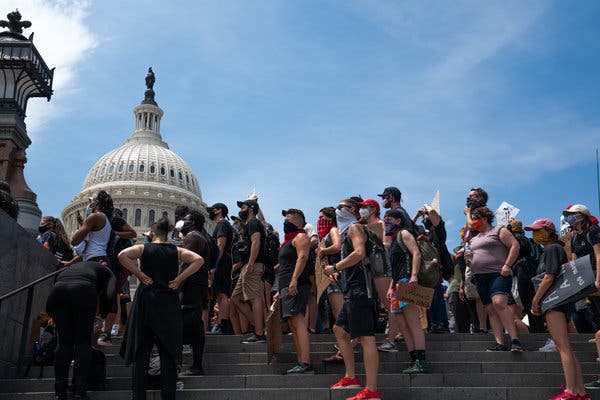Advertisement
Federal employees are being ushered back to office buildings under inconsistent and conflicting reopening plans, against the wishes of leaders in the nation’s capital.

WASHINGTON — As coronavirus cases surge around the country and epidemiologists urge caution, the federal government is heading back to work, jeopardizing pandemic progress in one of the few regions where confirmed infections continue to decline: the nation’s capital.
At the Energy Department’s headquarters, 20 percent of employees — possibly as many as 600 — have been authorized to return on a full- or part-time basis. The Interior Department said in a statement last month that it anticipated about 1,000 workers to soon return daily to its main office near the White House.
The Defense Department has authorized up to 80 percent of its work force to return to office spaces, which could result in as many as 18,000 employees inside the Pentagon building, according to a spokeswoman. Many of them are already there.
Private-sector employers remain hesitant to put workers back in their seats. Restaurant and bar owners around the country are shutting their doors anew. But agency chiefs at the nation’s largest employer, the 2.1 million-strong federal government, are taking their cues from an impatient President Trump and summoning employees to their desks.
“Federal employees have been working throughout the entire pandemic,” said Everett Kelley, the national president of the American Federation of Government Employees, the largest union representing federal workers in the District of Columbia. “To move them to a work site so the administration can say they reopened the government is irresponsible.”
Governments in the capital region are less than enthusiastic about a rush back. Coronavirus cases in Washington, Maryland and Virginia are now holding steady, but just days ago, cases in Washington had been declining.
A panel of public health experts chosen to inform Mayor Muriel E. Bowser’s reopening strategy in Washington recommended initially capping office buildings at 25 percent capacity, a threshold some federal agencies will soon exceed. In April, Gov. Ralph Northam of Virginia, Gov. Larry Hogan of Maryland and Ms. Bowser signed a letter urging the Trump administration to continue encouraging telework for the federal work force as much as possible.
And many private employers in the region, like Capital One, have closed their offices to nonessential workers until at least Labor Day.
But federal back-to-work orders are not changing. And that has local epidemiologists worried.
“You don’t want to negate all of the hard work that the D.C., Maryland, Virginia regions have done to reduce the number of cases of coronavirus in our region, by then returning everyone to work and potentially reversing the trends,” said Amanda Castel, an epidemiology professor at George Washington University.
Several agencies are still encouraging some telework while pressing supervisors and managers to identify employees to bring back to offices immediately.



